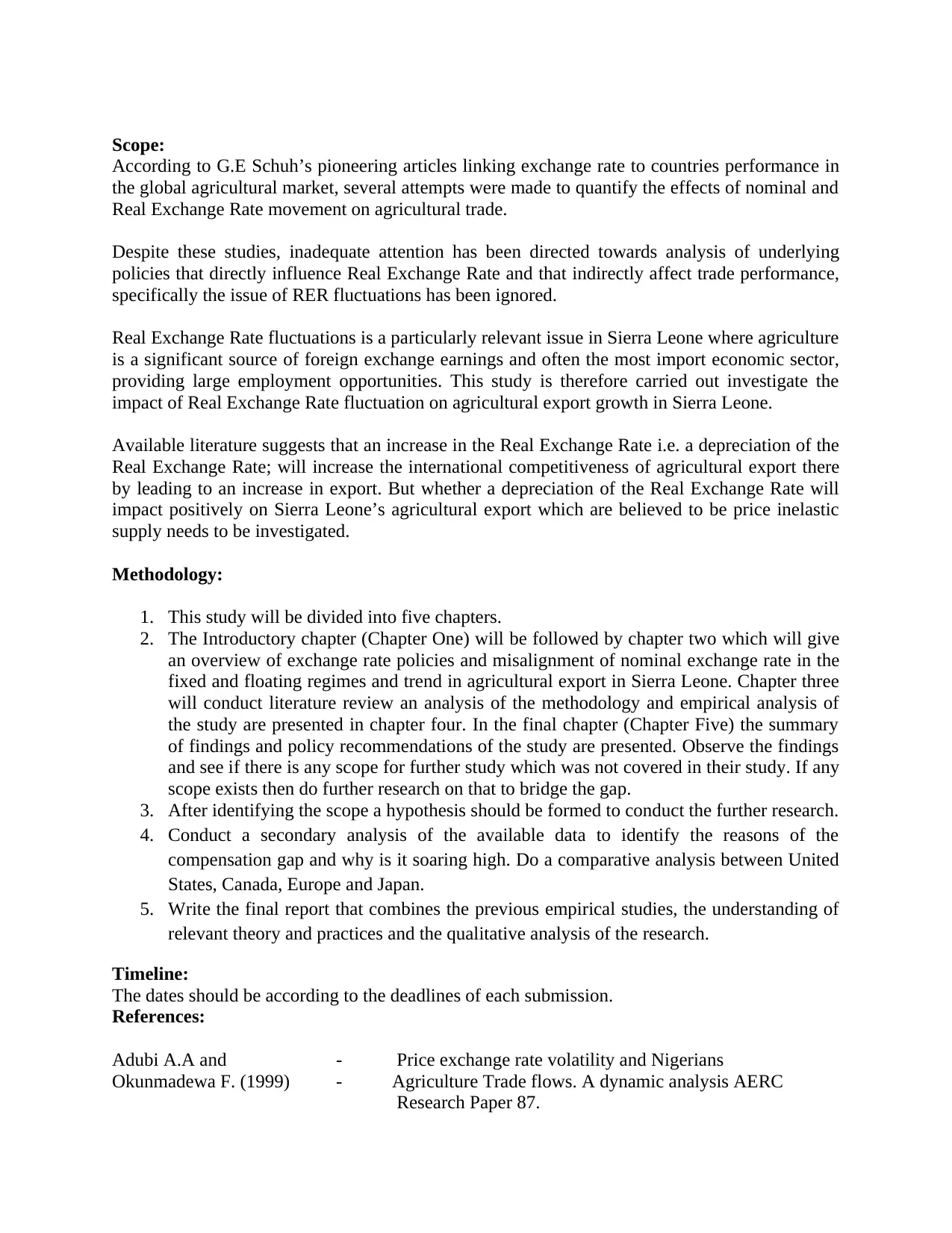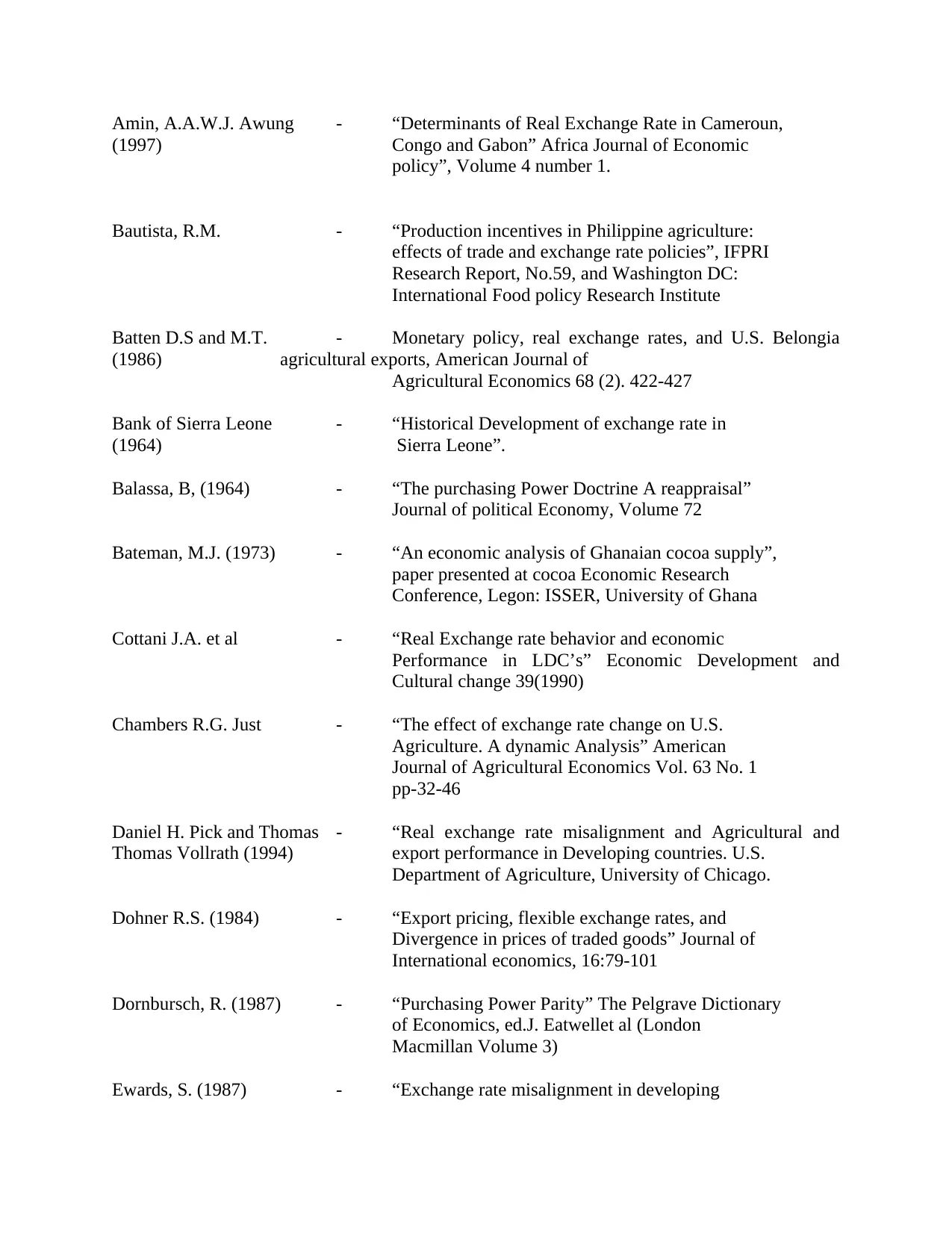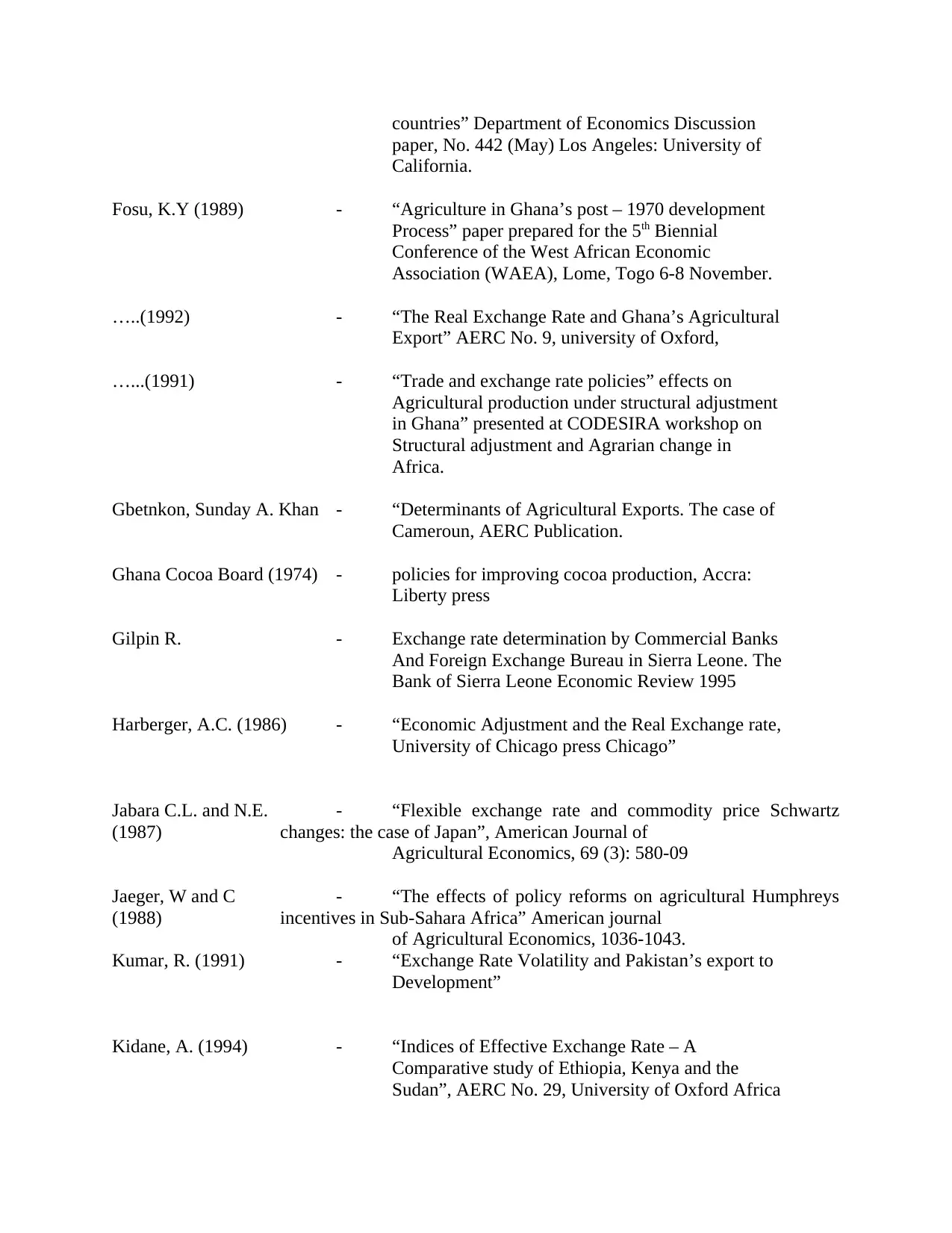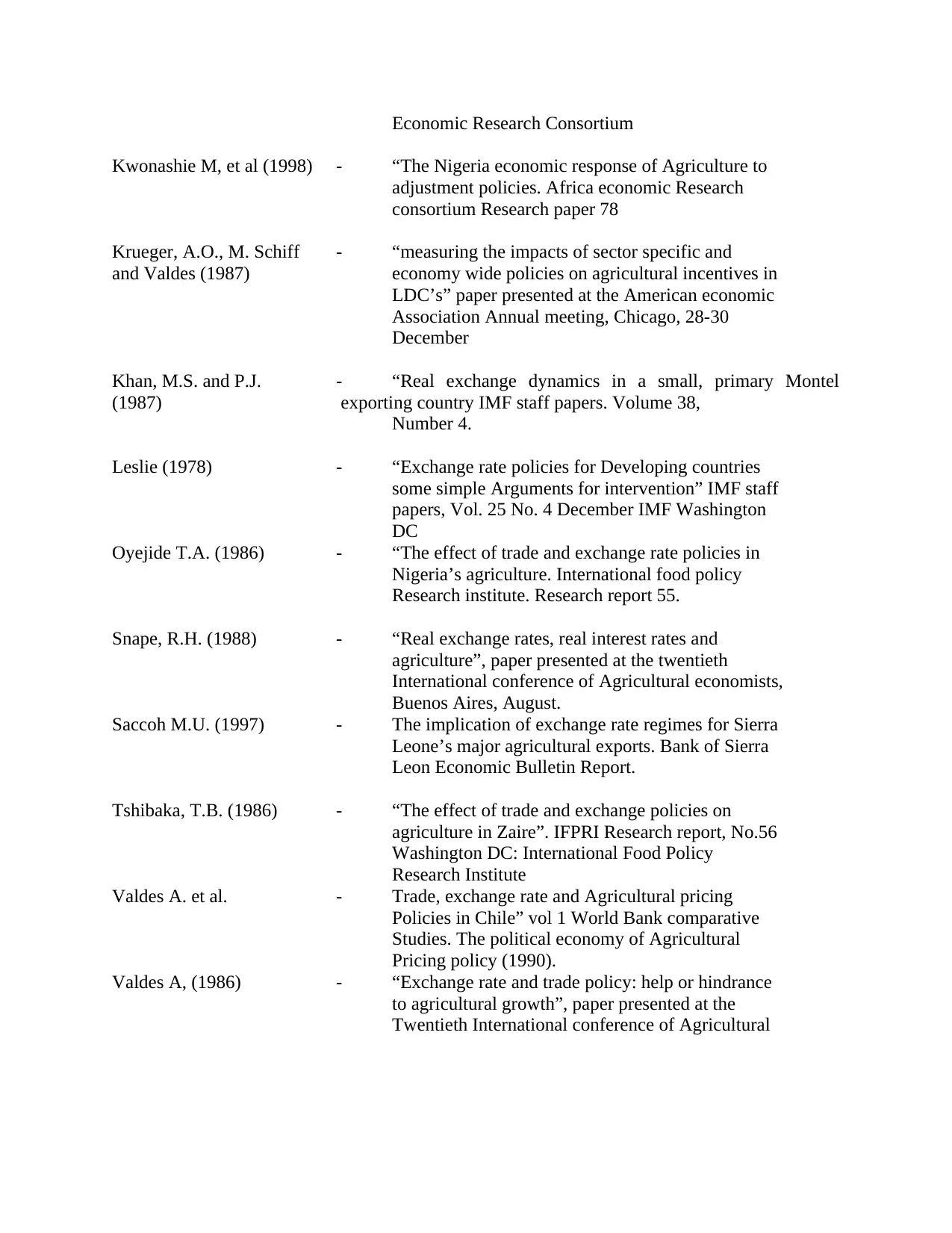Compensation Gap between 6-8 Countries
VerifiedAdded on 2019/09/20
|5
|1958
|431
Report
AI Summary
The provided content is a collection of research papers and studies on the topic of exchange rates, agriculture, and trade flows in various countries including Europe and Japan. The papers explore the impact of exchange rate volatility on agricultural production and exports, as well as the effects of policy reforms on agricultural incentives. Authors such as Adubi, Okunmadewa, Amin, Bautista, Bateman, Chambers, Daniel, Dohner, and many others have contributed to this collection of research papers, which aim to provide insights into the complex relationships between exchange rates, agriculture, and trade flows.
Contribute Materials
Your contribution can guide someone’s learning journey. Share your
documents today.

Research Topic:
The relationship between agricultural export growth and the Real Exchange Rate (RER) in Sierra
Leone
Purpose:
In Africa agriculture has some examples of successful development on a local basis, but the
broad trends over recent decades have been adverse. This been most evident in the overall
reduction in food security. West Africa economy is basically an agrarian and a critical look at the
structure of agriculture shows that, mainly it could be divided into subsistence and commercial
agriculture. The economy of Sierra Leone like other West Africa countries also rest heavily on
agriculture. This sector contributing more than 30 % of the GDP and agriculture produce account
for about 30 percent of the total foreign exchange earnings annually1. The importance of
agriculture in the Sierra Leone economy is further reflected by the fact that about 65% of the
total populations are currently finding their likelihood in agricultural activities. Crop production
is the main sub-sector as it contributes about three-quarter of agricultural value added with rice
holding the dominant position. Agriculture also accounts for about 10 % of export earnings2.
Background
It is however evident that total agriculture output has been falling annually. Even before the rebel
incursion, production had been declining at an annual rate of at least 3 percent3. The period
1970-1980s was characterized by poor agricultural export performance which has been blamed
mostly on inappropriate and in consistent macro and micro economic policies that were
implemented. These policies undermined local production and placed agricultural exports at a
major comparative disadvantage.
Prior to the stabilization and adjustment reforms, the government played a dominant role in
agricultural development including price regulation, exportation of cash crops and in some cases
undertaking direct production.
The role was mostly performance by the Sierra Leone Produce Marketing Board (SLPMB)
which was charged with the sole responsibility of handling a variety of export crops to market,
promote growth and stabilize price4.
Due to poor performance in agricultural export characterized by large fluctuations in world
prices, this made the authorities to resort to the reassessment and implementation of various trade
policies within a view of attracting satisfactory and sustainable responses from agriculture. These
policies were implemented under over valued domestic currency which means low price for farm
products5.
Through the economics adjustment agenda, exchange rate and trade reforms occupied a core
position. The Real Exchange Rate (RER) by virtue of its impact on the International
competitiveness of an economy, assumed an overriding importance among the cohort of policy
variables. The overvalued exchange rate system mentioned by the Sierra Leone government over
the years made the domestic price of tradable to fall in domestic currency terms and hence
discouraged the exportation of agricultural products
The relationship between agricultural export growth and the Real Exchange Rate (RER) in Sierra
Leone
Purpose:
In Africa agriculture has some examples of successful development on a local basis, but the
broad trends over recent decades have been adverse. This been most evident in the overall
reduction in food security. West Africa economy is basically an agrarian and a critical look at the
structure of agriculture shows that, mainly it could be divided into subsistence and commercial
agriculture. The economy of Sierra Leone like other West Africa countries also rest heavily on
agriculture. This sector contributing more than 30 % of the GDP and agriculture produce account
for about 30 percent of the total foreign exchange earnings annually1. The importance of
agriculture in the Sierra Leone economy is further reflected by the fact that about 65% of the
total populations are currently finding their likelihood in agricultural activities. Crop production
is the main sub-sector as it contributes about three-quarter of agricultural value added with rice
holding the dominant position. Agriculture also accounts for about 10 % of export earnings2.
Background
It is however evident that total agriculture output has been falling annually. Even before the rebel
incursion, production had been declining at an annual rate of at least 3 percent3. The period
1970-1980s was characterized by poor agricultural export performance which has been blamed
mostly on inappropriate and in consistent macro and micro economic policies that were
implemented. These policies undermined local production and placed agricultural exports at a
major comparative disadvantage.
Prior to the stabilization and adjustment reforms, the government played a dominant role in
agricultural development including price regulation, exportation of cash crops and in some cases
undertaking direct production.
The role was mostly performance by the Sierra Leone Produce Marketing Board (SLPMB)
which was charged with the sole responsibility of handling a variety of export crops to market,
promote growth and stabilize price4.
Due to poor performance in agricultural export characterized by large fluctuations in world
prices, this made the authorities to resort to the reassessment and implementation of various trade
policies within a view of attracting satisfactory and sustainable responses from agriculture. These
policies were implemented under over valued domestic currency which means low price for farm
products5.
Through the economics adjustment agenda, exchange rate and trade reforms occupied a core
position. The Real Exchange Rate (RER) by virtue of its impact on the International
competitiveness of an economy, assumed an overriding importance among the cohort of policy
variables. The overvalued exchange rate system mentioned by the Sierra Leone government over
the years made the domestic price of tradable to fall in domestic currency terms and hence
discouraged the exportation of agricultural products
Secure Best Marks with AI Grader
Need help grading? Try our AI Grader for instant feedback on your assignments.

Scope:
According to G.E Schuh’s pioneering articles linking exchange rate to countries performance in
the global agricultural market, several attempts were made to quantify the effects of nominal and
Real Exchange Rate movement on agricultural trade.
Despite these studies, inadequate attention has been directed towards analysis of underlying
policies that directly influence Real Exchange Rate and that indirectly affect trade performance,
specifically the issue of RER fluctuations has been ignored.
Real Exchange Rate fluctuations is a particularly relevant issue in Sierra Leone where agriculture
is a significant source of foreign exchange earnings and often the most import economic sector,
providing large employment opportunities. This study is therefore carried out investigate the
impact of Real Exchange Rate fluctuation on agricultural export growth in Sierra Leone.
Available literature suggests that an increase in the Real Exchange Rate i.e. a depreciation of the
Real Exchange Rate; will increase the international competitiveness of agricultural export there
by leading to an increase in export. But whether a depreciation of the Real Exchange Rate will
impact positively on Sierra Leone’s agricultural export which are believed to be price inelastic
supply needs to be investigated.
Methodology:
1. This study will be divided into five chapters.
2. The Introductory chapter (Chapter One) will be followed by chapter two which will give
an overview of exchange rate policies and misalignment of nominal exchange rate in the
fixed and floating regimes and trend in agricultural export in Sierra Leone. Chapter three
will conduct literature review an analysis of the methodology and empirical analysis of
the study are presented in chapter four. In the final chapter (Chapter Five) the summary
of findings and policy recommendations of the study are presented. Observe the findings
and see if there is any scope for further study which was not covered in their study. If any
scope exists then do further research on that to bridge the gap.
3. After identifying the scope a hypothesis should be formed to conduct the further research.
4. Conduct a secondary analysis of the available data to identify the reasons of the
compensation gap and why is it soaring high. Do a comparative analysis between United
States, Canada, Europe and Japan.
5. Write the final report that combines the previous empirical studies, the understanding of
relevant theory and practices and the qualitative analysis of the research.
Timeline:
The dates should be according to the deadlines of each submission.
References:
Adubi A.A and - Price exchange rate volatility and Nigerians
Okunmadewa F. (1999) - Agriculture Trade flows. A dynamic analysis AERC
Research Paper 87.
According to G.E Schuh’s pioneering articles linking exchange rate to countries performance in
the global agricultural market, several attempts were made to quantify the effects of nominal and
Real Exchange Rate movement on agricultural trade.
Despite these studies, inadequate attention has been directed towards analysis of underlying
policies that directly influence Real Exchange Rate and that indirectly affect trade performance,
specifically the issue of RER fluctuations has been ignored.
Real Exchange Rate fluctuations is a particularly relevant issue in Sierra Leone where agriculture
is a significant source of foreign exchange earnings and often the most import economic sector,
providing large employment opportunities. This study is therefore carried out investigate the
impact of Real Exchange Rate fluctuation on agricultural export growth in Sierra Leone.
Available literature suggests that an increase in the Real Exchange Rate i.e. a depreciation of the
Real Exchange Rate; will increase the international competitiveness of agricultural export there
by leading to an increase in export. But whether a depreciation of the Real Exchange Rate will
impact positively on Sierra Leone’s agricultural export which are believed to be price inelastic
supply needs to be investigated.
Methodology:
1. This study will be divided into five chapters.
2. The Introductory chapter (Chapter One) will be followed by chapter two which will give
an overview of exchange rate policies and misalignment of nominal exchange rate in the
fixed and floating regimes and trend in agricultural export in Sierra Leone. Chapter three
will conduct literature review an analysis of the methodology and empirical analysis of
the study are presented in chapter four. In the final chapter (Chapter Five) the summary
of findings and policy recommendations of the study are presented. Observe the findings
and see if there is any scope for further study which was not covered in their study. If any
scope exists then do further research on that to bridge the gap.
3. After identifying the scope a hypothesis should be formed to conduct the further research.
4. Conduct a secondary analysis of the available data to identify the reasons of the
compensation gap and why is it soaring high. Do a comparative analysis between United
States, Canada, Europe and Japan.
5. Write the final report that combines the previous empirical studies, the understanding of
relevant theory and practices and the qualitative analysis of the research.
Timeline:
The dates should be according to the deadlines of each submission.
References:
Adubi A.A and - Price exchange rate volatility and Nigerians
Okunmadewa F. (1999) - Agriculture Trade flows. A dynamic analysis AERC
Research Paper 87.

Amin, A.A.W.J. Awung - “Determinants of Real Exchange Rate in Cameroun,
(1997) Congo and Gabon” Africa Journal of Economic
policy”, Volume 4 number 1.
Bautista, R.M. - “Production incentives in Philippine agriculture:
effects of trade and exchange rate policies”, IFPRI
Research Report, No.59, and Washington DC:
International Food policy Research Institute
Batten D.S and M.T. - Monetary policy, real exchange rates, and U.S. Belongia
(1986) agricultural exports, American Journal of
Agricultural Economics 68 (2). 422-427
Bank of Sierra Leone - “Historical Development of exchange rate in
(1964) Sierra Leone”.
Balassa, B, (1964) - “The purchasing Power Doctrine A reappraisal”
Journal of political Economy, Volume 72
Bateman, M.J. (1973) - “An economic analysis of Ghanaian cocoa supply”,
paper presented at cocoa Economic Research
Conference, Legon: ISSER, University of Ghana
Cottani J.A. et al - “Real Exchange rate behavior and economic
Performance in LDC’s” Economic Development and
Cultural change 39(1990)
Chambers R.G. Just - “The effect of exchange rate change on U.S.
Agriculture. A dynamic Analysis” American
Journal of Agricultural Economics Vol. 63 No. 1
pp-32-46
Daniel H. Pick and Thomas - “Real exchange rate misalignment and Agricultural and
Thomas Vollrath (1994) export performance in Developing countries. U.S.
Department of Agriculture, University of Chicago.
Dohner R.S. (1984) - “Export pricing, flexible exchange rates, and
Divergence in prices of traded goods” Journal of
International economics, 16:79-101
Dornbursch, R. (1987) - “Purchasing Power Parity” The Pelgrave Dictionary
of Economics, ed.J. Eatwellet al (London
Macmillan Volume 3)
Ewards, S. (1987) - “Exchange rate misalignment in developing
(1997) Congo and Gabon” Africa Journal of Economic
policy”, Volume 4 number 1.
Bautista, R.M. - “Production incentives in Philippine agriculture:
effects of trade and exchange rate policies”, IFPRI
Research Report, No.59, and Washington DC:
International Food policy Research Institute
Batten D.S and M.T. - Monetary policy, real exchange rates, and U.S. Belongia
(1986) agricultural exports, American Journal of
Agricultural Economics 68 (2). 422-427
Bank of Sierra Leone - “Historical Development of exchange rate in
(1964) Sierra Leone”.
Balassa, B, (1964) - “The purchasing Power Doctrine A reappraisal”
Journal of political Economy, Volume 72
Bateman, M.J. (1973) - “An economic analysis of Ghanaian cocoa supply”,
paper presented at cocoa Economic Research
Conference, Legon: ISSER, University of Ghana
Cottani J.A. et al - “Real Exchange rate behavior and economic
Performance in LDC’s” Economic Development and
Cultural change 39(1990)
Chambers R.G. Just - “The effect of exchange rate change on U.S.
Agriculture. A dynamic Analysis” American
Journal of Agricultural Economics Vol. 63 No. 1
pp-32-46
Daniel H. Pick and Thomas - “Real exchange rate misalignment and Agricultural and
Thomas Vollrath (1994) export performance in Developing countries. U.S.
Department of Agriculture, University of Chicago.
Dohner R.S. (1984) - “Export pricing, flexible exchange rates, and
Divergence in prices of traded goods” Journal of
International economics, 16:79-101
Dornbursch, R. (1987) - “Purchasing Power Parity” The Pelgrave Dictionary
of Economics, ed.J. Eatwellet al (London
Macmillan Volume 3)
Ewards, S. (1987) - “Exchange rate misalignment in developing

countries” Department of Economics Discussion
paper, No. 442 (May) Los Angeles: University of
California.
Fosu, K.Y (1989) - “Agriculture in Ghana’s post – 1970 development
Process” paper prepared for the 5th Biennial
Conference of the West African Economic
Association (WAEA), Lome, Togo 6-8 November.
…..(1992) - “The Real Exchange Rate and Ghana’s Agricultural
Export” AERC No. 9, university of Oxford,
…...(1991) - “Trade and exchange rate policies” effects on
Agricultural production under structural adjustment
in Ghana” presented at CODESIRA workshop on
Structural adjustment and Agrarian change in
Africa.
Gbetnkon, Sunday A. Khan - “Determinants of Agricultural Exports. The case of
Cameroun, AERC Publication.
Ghana Cocoa Board (1974) - policies for improving cocoa production, Accra:
Liberty press
Gilpin R. - Exchange rate determination by Commercial Banks
And Foreign Exchange Bureau in Sierra Leone. The
Bank of Sierra Leone Economic Review 1995
Harberger, A.C. (1986) - “Economic Adjustment and the Real Exchange rate,
University of Chicago press Chicago”
Jabara C.L. and N.E. - “Flexible exchange rate and commodity price Schwartz
(1987) changes: the case of Japan”, American Journal of
Agricultural Economics, 69 (3): 580-09
Jaeger, W and C - “The effects of policy reforms on agricultural Humphreys
(1988) incentives in Sub-Sahara Africa” American journal
of Agricultural Economics, 1036-1043.
Kumar, R. (1991) - “Exchange Rate Volatility and Pakistan’s export to
Development”
Kidane, A. (1994) - “Indices of Effective Exchange Rate – A
Comparative study of Ethiopia, Kenya and the
Sudan”, AERC No. 29, University of Oxford Africa
paper, No. 442 (May) Los Angeles: University of
California.
Fosu, K.Y (1989) - “Agriculture in Ghana’s post – 1970 development
Process” paper prepared for the 5th Biennial
Conference of the West African Economic
Association (WAEA), Lome, Togo 6-8 November.
…..(1992) - “The Real Exchange Rate and Ghana’s Agricultural
Export” AERC No. 9, university of Oxford,
…...(1991) - “Trade and exchange rate policies” effects on
Agricultural production under structural adjustment
in Ghana” presented at CODESIRA workshop on
Structural adjustment and Agrarian change in
Africa.
Gbetnkon, Sunday A. Khan - “Determinants of Agricultural Exports. The case of
Cameroun, AERC Publication.
Ghana Cocoa Board (1974) - policies for improving cocoa production, Accra:
Liberty press
Gilpin R. - Exchange rate determination by Commercial Banks
And Foreign Exchange Bureau in Sierra Leone. The
Bank of Sierra Leone Economic Review 1995
Harberger, A.C. (1986) - “Economic Adjustment and the Real Exchange rate,
University of Chicago press Chicago”
Jabara C.L. and N.E. - “Flexible exchange rate and commodity price Schwartz
(1987) changes: the case of Japan”, American Journal of
Agricultural Economics, 69 (3): 580-09
Jaeger, W and C - “The effects of policy reforms on agricultural Humphreys
(1988) incentives in Sub-Sahara Africa” American journal
of Agricultural Economics, 1036-1043.
Kumar, R. (1991) - “Exchange Rate Volatility and Pakistan’s export to
Development”
Kidane, A. (1994) - “Indices of Effective Exchange Rate – A
Comparative study of Ethiopia, Kenya and the
Sudan”, AERC No. 29, University of Oxford Africa
Paraphrase This Document
Need a fresh take? Get an instant paraphrase of this document with our AI Paraphraser

Economic Research Consortium
Kwonashie M, et al (1998) - “The Nigeria economic response of Agriculture to
adjustment policies. Africa economic Research
consortium Research paper 78
Krueger, A.O., M. Schiff - “measuring the impacts of sector specific and
and Valdes (1987) economy wide policies on agricultural incentives in
LDC’s” paper presented at the American economic
Association Annual meeting, Chicago, 28-30
December
Khan, M.S. and P.J. - “Real exchange dynamics in a small, primary Montel
(1987) exporting country IMF staff papers. Volume 38,
Number 4.
Leslie (1978) - “Exchange rate policies for Developing countries
some simple Arguments for intervention” IMF staff
papers, Vol. 25 No. 4 December IMF Washington
DC
Oyejide T.A. (1986) - “The effect of trade and exchange rate policies in
Nigeria’s agriculture. International food policy
Research institute. Research report 55.
Snape, R.H. (1988) - “Real exchange rates, real interest rates and
agriculture”, paper presented at the twentieth
International conference of Agricultural economists,
Buenos Aires, August.
Saccoh M.U. (1997) - The implication of exchange rate regimes for Sierra
Leone’s major agricultural exports. Bank of Sierra
Leon Economic Bulletin Report.
Tshibaka, T.B. (1986) - “The effect of trade and exchange policies on
agriculture in Zaire”. IFPRI Research report, No.56
Washington DC: International Food Policy
Research Institute
Valdes A. et al. - Trade, exchange rate and Agricultural pricing
Policies in Chile” vol 1 World Bank comparative
Studies. The political economy of Agricultural
Pricing policy (1990).
Valdes A, (1986) - “Exchange rate and trade policy: help or hindrance
to agricultural growth”, paper presented at the
Twentieth International conference of Agricultural
Kwonashie M, et al (1998) - “The Nigeria economic response of Agriculture to
adjustment policies. Africa economic Research
consortium Research paper 78
Krueger, A.O., M. Schiff - “measuring the impacts of sector specific and
and Valdes (1987) economy wide policies on agricultural incentives in
LDC’s” paper presented at the American economic
Association Annual meeting, Chicago, 28-30
December
Khan, M.S. and P.J. - “Real exchange dynamics in a small, primary Montel
(1987) exporting country IMF staff papers. Volume 38,
Number 4.
Leslie (1978) - “Exchange rate policies for Developing countries
some simple Arguments for intervention” IMF staff
papers, Vol. 25 No. 4 December IMF Washington
DC
Oyejide T.A. (1986) - “The effect of trade and exchange rate policies in
Nigeria’s agriculture. International food policy
Research institute. Research report 55.
Snape, R.H. (1988) - “Real exchange rates, real interest rates and
agriculture”, paper presented at the twentieth
International conference of Agricultural economists,
Buenos Aires, August.
Saccoh M.U. (1997) - The implication of exchange rate regimes for Sierra
Leone’s major agricultural exports. Bank of Sierra
Leon Economic Bulletin Report.
Tshibaka, T.B. (1986) - “The effect of trade and exchange policies on
agriculture in Zaire”. IFPRI Research report, No.56
Washington DC: International Food Policy
Research Institute
Valdes A. et al. - Trade, exchange rate and Agricultural pricing
Policies in Chile” vol 1 World Bank comparative
Studies. The political economy of Agricultural
Pricing policy (1990).
Valdes A, (1986) - “Exchange rate and trade policy: help or hindrance
to agricultural growth”, paper presented at the
Twentieth International conference of Agricultural
1 out of 5
Related Documents
Your All-in-One AI-Powered Toolkit for Academic Success.
+13062052269
info@desklib.com
Available 24*7 on WhatsApp / Email
![[object Object]](/_next/static/media/star-bottom.7253800d.svg)
Unlock your academic potential
© 2024 | Zucol Services PVT LTD | All rights reserved.





